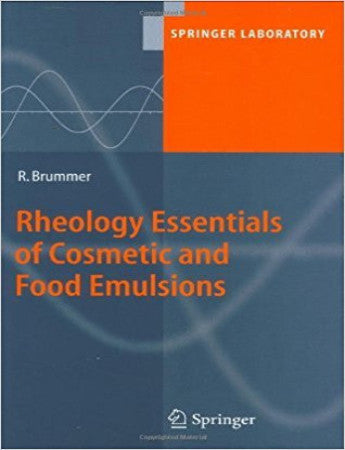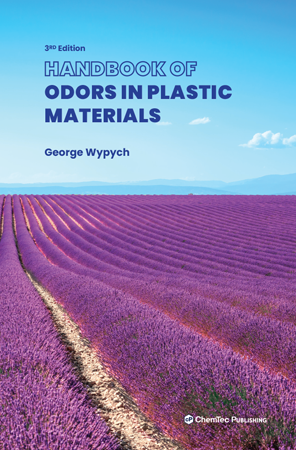Cosmetic emulsions exist today in many forms for a wide variety of applications, including face and hand creams for normal, dry or oily skin, body milks, and lotions, as well as sun-block products. Keeping track of them and their properties are not always easy despite informative product names or partial names (e.g. hand or face cream) that clearly indicate their use and properties. This practical manual provides a detailed overview that describes the key properties and explains how to measure them using modern techniques. Written by expert inflows and flow properties, it focuses on the application of rheological (flow) measurements to cosmetic and food emulsions and the correlation of these results with findings from other tests.
Beginning with a brief history of rheology and some fundamental principles, the manual describes in detail the use of modern viscometers and rheometers, including concise explanations of the different available instruments. But the focus remains on practical everyday lab procedures: how to characterize cosmetic and food emulsions with different rheological tests such as temperature, time, stress and strain, both static and dynamic. Also the critical topic of how the results correlate with other important product characteristics, for instance, skin sensation, pumping performance, stability etc. is carefully explored. Many pictures, illustrations, graphs, and tables help readers new to the measurement of cosmetic emulsions in their daily work as well as to the more experienced who seek additional special tips and tricks.
1 INTRODUCTION (pg. 1)
2 A TRIP BACK IN TIME (pg. 5)
3 SKIN AND ITS CARE (pg. 15)
4 EMULSIONS – SOME THEORETICAL ASPECTS (pg. 17)
4.1 Physicochemical Structure of Cosmetic Products (pg.17)
4.2 Modern Emulsifiers (pg. 19)
4.3 Skin Care and Cleansing (pg. 19)
4.4 Microemulsions (pg. 19)
4.5 Emulsifier-Free Products (pg. 20)
4.6 Production of Emulsions (pg.21)
4.7 Processes occurring during Emulsification (pg. 21)
4.8 Serrated Disc Disperser (pg. 22)
5 BASIC PHYSICAL AND MATHEMATICAL PRINCIPLES (pg. 25)
5.1 Important Definitions (pg. 25)
5.2 One-Dimensional Parallel PlatesModel (pg. 28)
5.3 Parallel PlateMeasuring System (pg. 30)
5.4 Cone-PlateMeasuring System (pg. 31)
5.5 Coaxial Cylinder Systems (pg. 32)
5.6 Double GapMeasuring System (pg. 35)
5.7 Flow Through Circular Capillary (pg. 36)
5.8 CorrectionMethods (pg. 38)
5.8.1 PPMeasurement System (pg. 39)
5.8.2 Cylinder Measurement Systems (pg. 39)
5.8.3 Circular Capillaries (pg. 39)
5.9 Deformation and Relaxation 40)
5.10 Thixotropy and Rheopexy (pg. 43)
5.11 Vibration orOscillationMeasurements (pg. 44)
5.11.1 Steady andDynamic Stress (pg. 45)
5.11.2 Ideal Elastic Solids (pg. 46)
5.11.3 IdealViscous Fluids (pg. 46)
5.11.4 Real Solids (pg. 47)
5.11.5 Complex Representation (pg. 48)
XVI)
6 MEASURING INSTRUMENTS (pg. 51)
6.1 Modern Rheometer (pg. 52)
6.2 High Shear Rheometer (pg. 54)
6.3 StandardViscometer (pg. 55)
6.4 OftenUsedViscometer (pg. 56)
6.5 Automatic Sampler (pg. 57)
6.6 In-process In-/On-line Viscosity Measurements (pg. 58)
6.7 Future Prospects (pg. 61)
7 MOST IMPORTANT TEST METHODS (pg. 63)
7.1 Stress Ramp Test (pg. 65)
7.2 Newtonian Flow Behavior (pg. 67)
7.3 Creep Test and Creep Recovery (pg. 67)
7.4 The Ideal Elastic Behavior (pg. 68)
7.5 The IdealViscous Behavior (pg. 68)
7.6 RealViscoelastic Behavior (pg. 69)
7.7 Steady Flow Curve (pg. 69)
7.8 AmplitudeDependence (pg. 71)
7.9 Structure Breakdown and BuildUp (pg. 73)
7.10 TimeDependence (pg. 74)
7.11 Frequency Test (pg. 75)
7.12 Temperature Dependence (pg. 76)
7.13 Combined Temperature-Time Test (pg. 77)
8 ANALYSIS OF MEASURING RESULTS AND CORRELATIONS)
WITH OTHER TESTS (pg. 81)
8.1 Yield Stress (pg. 81)
8.1.1 Correlations of the Yield Stress with the Primary Skin Feel (pg. 82)
8.1.2 Optimization of the Stress Ramp Test (pg. 83)
8.1.3 Residue Emptying (pg. 85)
8.1.4 Energy Input (pg. 87)
8.1.4.1 Measurement of the Energy Input (pg. 88)
8.1.5 Droplet Sizes and their Distribution (pg. 90)
8.1.6 Pumpability of Cosmetic Emulsions (pg. 92)
8.1.6.1 Estimation of the Maximum Shear Rate (pg. 93)
8.1.6.2 Calculation of the Shear Stress (pg. 94)
8.1.7 Stability Studies Using Yield Stress Measurements (pg. 95)
8.1.8 Results Obtained (pg. 96)
8.2 Steady Flow (pg. 97)
8.2.1 Determination of the Measuring Time (pg. 97)
8.2.2 Temperature Dependence of the Dynamic Viscosity (pg. 98)
8.2.3 Secondary Skin Feel (pg. 99)
8.2.3.1 Investigation of the Secondary Skin Feel (pg. 100)
8.3 OscillatoryMeasurements (pg. 101)
8.3.1 Temperature Dependence of the Moduli (pg. 106)
8.3.2 Temperature Stability (pg. 110)
8.3.3 Rheological Swing Test for Temperature Stability (pg. 112)
8.4 Time Temperature Superposition (TTS) (pg. 117)
8.4.1 Softening Point (pg. 118)
8.4.2 Freezing Point (pg. 118)
8.4.3 Determination of the Master Curve at Constant Frequency (pg.118)
8.4.3.1 Determination of the Activation Energy)
via the Temperature (pg.119)
8.4.3.2 Viscosity (pg. 119)
8.4.3.3 Arrhenius Equation (pg. 120)
8.4.3.4 WLF Equation (pg. 122)
8.4.3.5 First Conclusion (pg. 122)
8.4.3.6 Determination of the Master Curve)
with Variable Frequency (pg. 123)
8.4.3.7 Final Conclusion (pg. 124)
9 INTERPRETATION (pg. 125)
9.1 Relationships for Polymers (pg. 125)
9.2 General Statements for Cosmetic Emulsions (pg. 127)
10 CALIBRATION/VALIDATION (pg. 131)
10.1 Basic Principles of Statistical Analysis (pg. 133)
10.1.1 NormalDistribution (GaussianDistribution) (pg. 133)
10.1.2 MeanValue (pg. 134)
10.1.3 True Value (pg. 135)
10.1.4 StandardDeviation andVariance (pg. 135)
10.1.4.1 StandardDeviation (pg. 136)
10.1.4.2 Coefficient ofVariation (pg. 136)
10.1.5 MeasuredValue, Result, RandomVariable (pg. 136)
10.1.6 Population, Series,MeasuredValue (pg. 137)
10.1.7 Errors andDeviations (pg. 137)
10.1.7.1 Error Types (pg. 137)
10.1.8 Precision (pg. 138)
10.1.9 Accuracy (pg. 139)
10.1.10 Trueness (pg. 139)
10.1.11 Repeatability (pg. 139)
10.1.12 Reproducibility (pg. 140)
10.1.13 Outliers (pg. 140)
10.2 Back to the Laboratory (pg. 140)
10.2.1 Calibration Test forOscillatoryMeasurements (pg. 143)
10.2.2 Temperature (pg. 145)
11 TIPS AND TRICKS (pg. 147)
11.1 Materials for Geometric Systems (pg. 147)
11.2 Cone-plate (pg. 147)
11.3 Parallel Plate (pg. 148)
11.4 Cylinder Systems (pg. 148)
11.5 Cleaning Measuring Systems (pg. 148)
11.6 Measurement Artifacts (pg. 149)
11.7 Filling of Cone-plate and Parallel Plate Measuring Systems (pg. 150)
11.8 Interpretation (pg. 152)
12 DEFINITION OF COSMETICS (pg. 155)
12.1 Cosmetics vs.Drugs (pg. 155)
12.2 Production of Cosmetic Products (pg. 155)
12.3 Naming, Trademark Law, Patents Law (pg. 156)
12.4 Marketing of Cosmetic Products (pg. 156)
12.5 Advertising Cosmetic Products (pg. 157)
12.6 Comments (pg. 160)
13 EXCURSION IN THEWORLD OF FOOD RHEOLOGY (pg. 161)
13.1 AShort History of Food Rheology (pg. 161)
13.1.1 TheOrigins of Food Rheology (pg. 163)
13.2 Honey (pg. 163)
13.3 Sandwich Spreads (pg. 164)
13.4 Cheese (pg. 165)
13.5 Ketchup (pg. 165)
13.6 Yoghurt (pg. 166)
13.7 Marzipan (pg. 166)
13.8 Starch (pg. 168)
13.9 Foams (pg. 169)
13.10 Chocolate (pg. 170)
13.11 Psychorheology (pg. 170)
14 LIST OF REFERENCES (pg. 173)
15 SUBJECT INDEX (pg. 177)




